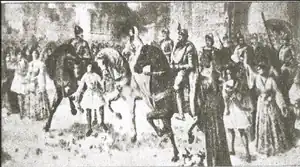Andronika (Donika) Kastrioti | |
|---|---|
| Lady of Albania | |
 | |
| Full name | Andronika (Donika) Arianiti-Comneniates Muzaka |
| Born | 1428 Kaninë, Ottoman Empire (modern day Albania) |
| Died | 1506 (Aged 78) Valencia, Kingdom of Valencia (modern day Spain) |
| Buried | Royal Monastery of the Holy Trinity (Valencia) |
| Noble family | |
| Spouse | Skanderbeg |
| Issue | Gjon Kastrioti II |
| Father | Gjergj Arianiti |
| Mother | Maria Muzaka |
Andronika Arianiti, also known as Donika Kastrioti, [a] (born 1428 – died 1506) was an Albanian noblewoman and the spouse of Albanian leader and national hero Skanderbeg (born Gjergj Kastrioti). She was the daughter of Gjergj Arianiti, an earlier leader in the ongoing revolt against the Ottomans.
Life

Donika was born in Kaninë, in 1428. Her father, Gjergj Arianiti was a member of the Arianiti family whose domain stretched across the Shkumbin valley and the old Via Egnatia road and reached to the east today's Bitola. Her mother, Maria Muzaka was a member of the Muzaka family whose domain was the Myzeqe region.[1]
A month after the Treaty of Gaeta, on 21 April 1451, Skanderbeg married Donika, and thus strengthened the ties with the Arianiti family,[2] in the Eastern Orthodox Ardenica Monastery,[3][4] in Lushnje, present-day southwestern Albania. Later her sister Angelina married Serbian ruler Stefan Branković. She is venerated as a saint in the Serbian Orthodox Church.[5]
After the Ottoman conquest of Albania, the Kastriotis were given peerage in the Kingdom of Naples.[6] They obtained a feudal domain, the Duchy of San Pietro in Galatina and the County of Soleto (Province of Lecce, Italy).[7] Gjon Kastrioti II, Donika's and Skanderbeg's only child, married Jerina Branković, the daughter of Lazar Branković, Despot of Serbia.[7]
Donika had a close friendship with the second wife of King Ferdinand I of Naples, Joanna of Aragon who is also the sister of Ferdinand of Aragon. After the beginning of the Italian War of 1494–1498, Donika was forced to leave Naples and arrived in Valencia around 1501 along with her grandchild, Alonso Kastrioti.[8] They found refuge in the royal palace.
Notes
- ^ Her name is mentioned as Andronica Comneniates in Gjon Muzaka's work about the Muzaka family.[9] Oliver Jens Schmitt names her Andronika Arianiti in his biographical work on Skanderbeg.[10]
References
- ↑ Anamali, Skënder (2002), Historia e popullit shqiptar në katër vëllime (in Albanian), vol. I, Botimet Toena, pp. 255–257, OCLC 52411919
- ↑ Frashëri, Kristo (2002), Gjergj Kastrioti Skënderbeu: jeta dhe vepra, 1405–1468 (in Albanian), Botimet Toena, p. 181, ISBN 99927-1-627-4
- ↑ Elsie, Robert (2000). A dictionary of Albanian religion, mythology, and folk culture. New York University Press. p. 14. ISBN 0-8147-2214-8.
- ↑ Gjika, Ilirjan. "Manastiri i Ardenices" (in Albanian). Retrieved 28 July 2010.
- ↑ Elsie, Robert (2001). A dictionary of Albanian religion, mythology and folk culture. C. Hurst. p. 9. ISBN 978-1-85065-570-1. Retrieved 26 November 2010.
- ↑ Gibbon, Edward (1901) [1802], The decline and fall of the Roman empire, P. F. Collier & Son, p. 467, OCLC 317326240
- 1 2 Runciman, Steven (1990), The fall of Constantinople, 1453, Cambridge University Press, pp. 183–185, ISBN 978-0-521-39832-9
- ↑ The Untold Story: Skanderbeg’s Wife’s Life and Death in Exile on YouTube
- ↑ John Musachi: Brief Chronicle on the Descendants of our Musachi Dynasty Archived September 10, 2010, at the Wayback Machine
- ↑ Schmitt Oliver, Skanderbeg, Der neue Alexander auf dem Balkan, Verlag Friedrich Pustet, 2009, p. 45
![]() Media related to Andronika Arianiti at Wikimedia Commons
Media related to Andronika Arianiti at Wikimedia Commons